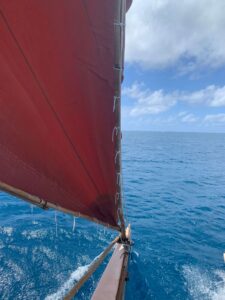Dr. Elise Huffer here reports on another of the exciting “satellite projects” implemented in the Pacific by Ocean States’ network members. These diverse satellite activities, which include the Ma’ohi Nui project by Vehia Wheeler (reported on in a previous blog post in April 2021) had their origins in the global pandemic lockdown from 2020 onward, when the Norway-grounded Ocean States team in Bergen collaborated with similarly grounded colleagues in the Pacific Islands region to mitigate the ill effects of the lockdown. Dr. Huffer is Fiji-based, and is a distinguished regional expert in culture and development, currently serving as Vice Chair Oceania of the Commission on Environmental, Economic and Social Policy under the International Union for the Conservation of Nature (IUCN). Here, she discusses how Ocean States is building knowledge and understanding of ocean cultural connectivity.
Written by Elise Huffer

I remember, some years ago, a colleague at the University of the South Pacific (which, in Fiji, faces the sea) compared the ocean to a desert. He said it dismissively, implying that the ocean was just a large, desolate and empty space. His assertion disturbed me at the time and has stayed with me. It was in complete contradiction with what, in Oceania, is an ancestral, peopled, imagined, revered, traveled, vital, life sustaining and enriching body of water, a cultural and lived space. (We know, of course, that deserts are also peopled, imagined, revered and vital places for the communities that ‘descend’ from them. And this even though today, deserts, much like the ocean succumbing to sea-level rise, are in places encroaching fertile land due habitat destruction and increasing human-induced climate change but that is a story for another day). Since hearing that statement, a small voice at back of my mind has been egging me on to confront this misplaced view; a view which enables humanity to ignore the welfare of the ocean with an ‘out of sight, out of mind’ attitude, leading to all manners of pollution, industrial, nuclear, chemical and agricultural, various forms of run-off from land and mistreatment through over-fishing, war games, and now experimental deep-sea exploration and mining.
It is only recently that the global community has begun paying comprehensive attention to the ocean in the hopes of addressing decades of human impact. There has been a flurry of activity with the adoption of the UN Decade of Ocean Science for Sustainable Development (2021-2030) which amplifies Sustainable Development Goal 14 (to conserve and sustainably use the oceans, seas and marine resources for sustainable development) of the 2030 Agenda for Sustainable Development launched in 2015; the 2022 Kunming-Montreal Global Biodiversity Framework’s Target 3 which “calls for the effective protection and management of 30% of the world’s terrestrial, inland water, and coastal and marine areas by the year 2030”[1] (what is generally referred to as ‘30 by 30’); the conclusion and adoption in 2023 of the Agreement under the United Nations Convention on the Law of the Sea on the Conservation and Sustainable Use of Marine Biological Diversity of Areas Beyond National Jurisdiction (commonly known as the BBNJ treaty); the 2023 adoption by the International Maritime Organisation (IMO) of a strategy to reduce greenhouse emissions, and the ongoing negotiations, which began in earnest in 2022, to “Develop an International Legally Binding Instrument on Plastic Pollution, including in the Marine Environment” and are going into the fifth Intergovernmental Negotiating Committee session at the end of 2024.[2] These global measures have supplemented longer standing actions on, for example, the protection of marine species such as whales through the International Whaling Commission, or the 1992 banning of large fishing driftnets in international waters. Importantly, they indicate a welcome shift: the ocean has become a visible and global priority. The question remains though, how effective these initiatives will be in the face of ongoing economic and consumption patterns, and increased energy needs to fuel the type of economic development that communities across the planet expect, and the looming threat of deep-sea mining.
A further question, for our purposes, is what this has to do with culture and Oceania more specifically. Pacific Island countries have long been at the forefront of ocean protection. They played a major role in advocating for the banning of driftnets in the high seas in the Pacific in the late 1980s and early 1990s which resulted in the global ban, through the Tarawa and then the Wellington Declarations.[3] They have established the highest number of national and regional sanctuaries for migratory species, particularly sharks[4] and whales, as well as large scale marine protected areas.[5] And they have done this, in large part, in recognition of the special and enduring cultural connections of their peoples with the ocean established through centuries of navigation and traditional voyaging traditions. Crossing the ocean and communing with its waves, currents, winds and animals has been at the core of Oceanian peoples’ identities. Pacific communities have long standing kinships with iconic migratory species such as sharks, whales, turtles, sea birds, relationships based on and manifested through “cultural and spiritual practices… which are often intertwined with the use and care of the species” as well as on “subsistence harvest [ing].”[6] As Willy Kostka of Palau explains: “Some islanders depend on sharks for sustenance and utilize the remaining parts for making traditional tools, jewelries and handicrafts, while others consider sharks as ancestral deities and totems” adding that as “sharks are migratory, we [in Micronesia have seen] the need for cooperation between jurisdictions to ensure protection and consistent enforcement.”[7]
The cultural value of the ocean and the sacred and ongoing ancestral relationships with its marine inhabitants and features, were fundamental in driving the Pacific Islands to push for the inclusion of traditional knowledge in the text and future application of the BBNJ agreement. This was a major undertaking as traditional knowledge has not been well understood globally and its acceptance in the treaty text required a comprehensive effort by Pacific academics and legal experts alongside leaders and Pacific diplomats in New York.[8] The inclusion of traditional knowledge and Indigenous peoples and local communities in the BBNJ is a major milestone for Oceania and reflects ongoing deep connections with the ocean. The list of further actions by Pacific Islands countries to work to protect the ocean is long and includes full and consistent participation, if not leadership, in the global actions now being undertaken. An important element to support this effort is to continue to better articulate the breadth and importance of Oceanian cultural values and practices to ensure they are fully integrated in ocean policy in the region and globally.

The Island Lives. Ocean States project hosted at the University of Bergen has been a contributor to this effort, through various actions, one of which I have had the privilege of working on, which has consisted in establishing the foundation for an inventory/catalogue and web portal on ocean Indigenous/traditional knowledge. Currently, the data on Pacific Ocean cultural connectivity is scattered and difficult to access making it challenging to bring this essential knowledge source and content to the fore. It has put Indigenous/traditional knowledge holders and Pacific Islands researchers, scholars and practitioners at a disadvantage in influencing and participating in decision making in ocean resource management.
The project began at USP with the collation of publications focused on Pacific Ocean I/TK and has now entered a second phase to assess how best to develop the portal in collaboration with the Pacific Community (SPC) and other regional agencies. The assessment, conducted by two regional information and knowledge management specialists supported by the Pacific Solutions to Save our Oceans – Integrated Ocean Management Programme – PSIOM[9] and under the guidance of a trans-disciplinary team, has already led to some deep thinking by convened focus groups and regional experts about the appropriate framing for the cataloguing of ocean cultural connectivity and Indigenous/traditional knowledge materials. This is the first such initiative for Oceania as a whole and it has created excitement about the potential for generating new forms of vocabularies drawing on Pacific ontologies and epistemologies and for creating much greater participation by Pacific custodians of Indigenous/traditional knowledge in generating new materials and forms of documentation.
But the impact of the Island Lives, Ocean States doesn’t end there. The project has also fostered new and exciting activities such as the programming of two whale webinars[10] (March and May 2023) focused on human-animal kinship, and the convening of a session dedicated to ocean culture at the International Marine Protected Areas Congress (IMPAC 5) in February 2023 (see https://iucn.org/story/202206/moving-culture-across-ocean-policy and https://iucn.org/story/202303/powerful-voices-and-indigenous-wisdom-marine-conservation-congress). In March 2024, building on these initiatives, a ‘first of its kind’ meeting on animal culture and human-animal kinship was held in partnership with the University of Auckland and the Whales and Dolphin Conservation (WDC), with support of the UNESCO New Zealand National Commission. New pathways for increasing ocean cultural connectivity visibility are being mapped out as this is being written, demonstrating the lasting and ongoing benefits of Island Lives, Ocean States even as the project closes.


Elise is based in Fiji and has been working as a cultural consultant since the end of 2017. She has worked in a range of areas including heritage, cultural industries and culture in conservation and development. Prior to 2017, Elise was the Culture Adviser in the Social Development Division of the Pacific Community (SPC), a position she took up in 2008. There Elise was responsible for promoting the development of the culture sector in the Pacific Islands region, working directly with governments, non-governmental organizations and other regional and international agencies. Prior to joining SPC, Elise worked at the Institute of Pacific Studies at the University of the South Pacific for 10 years.
[1] See https://www.nature.org/en-us/what-we-do/our-priorities/protect-water-and-land/land-and-water-stories/committing-to-30×30/
[2] See https://enb.iisd.org/plastic-pollution-marine-environment-negotiating-committee-inc4-summary
[3] See, for instance, Richards, A. H. (1994) Problems of drift-net fisheries in the South Pacific, Marine Pollution Bulletin, Vol. 29, Issues 1-3, pp.106-111. Available at https://www.sciencedirect.com/science/article/abs/pii/0025326X94904332
[4] The Pacific hosts half of the world’s shark sanctuaries. See “How the Pacific paved the path to successful shark conservation”, published by Pew Trust, December 16, 2019, accessed at https://www.pewtrusts.org/en/research-and- analysis/articles/2019/12/16/how-the-pacificregion-paved-the-path-to-successful-shark-conservation
[5] Ibid.
[6] See Vierros, M, K, et.al, .2020. Considering Indigenous Peoples and local communities in governance of the global ocean commons, Marine Policy, Vol. 119, September 2020. Accessible at https://doi.org/10.1016/j.marpol.2020.104039
[7] Ibid.
[8] See notably Mulalap, C. Y. et al, 2020. Traditional Knowledge and the BBNJ Instrument, Marine Policy, 122 (2020) 104103. https://www.sciencedirect.com/science/article/pii/S0308597X19308620?casa_token=-lgLj79guqYAAAAA:KYgr5oonHeiWygvWp3Nw37dLgSf2OtmdWp58Kq3hb1toI-wzxv8kJ1AqMfggtZJkUBIFu0c2EQ
[9] See https://gem.spc.int/projects/pacific-solutions-to-save-our-ocean-integrated-ocean-management-programme
[10] Available here: https://www.earthlaws.org.au/event/orka-kinship-with-whales/